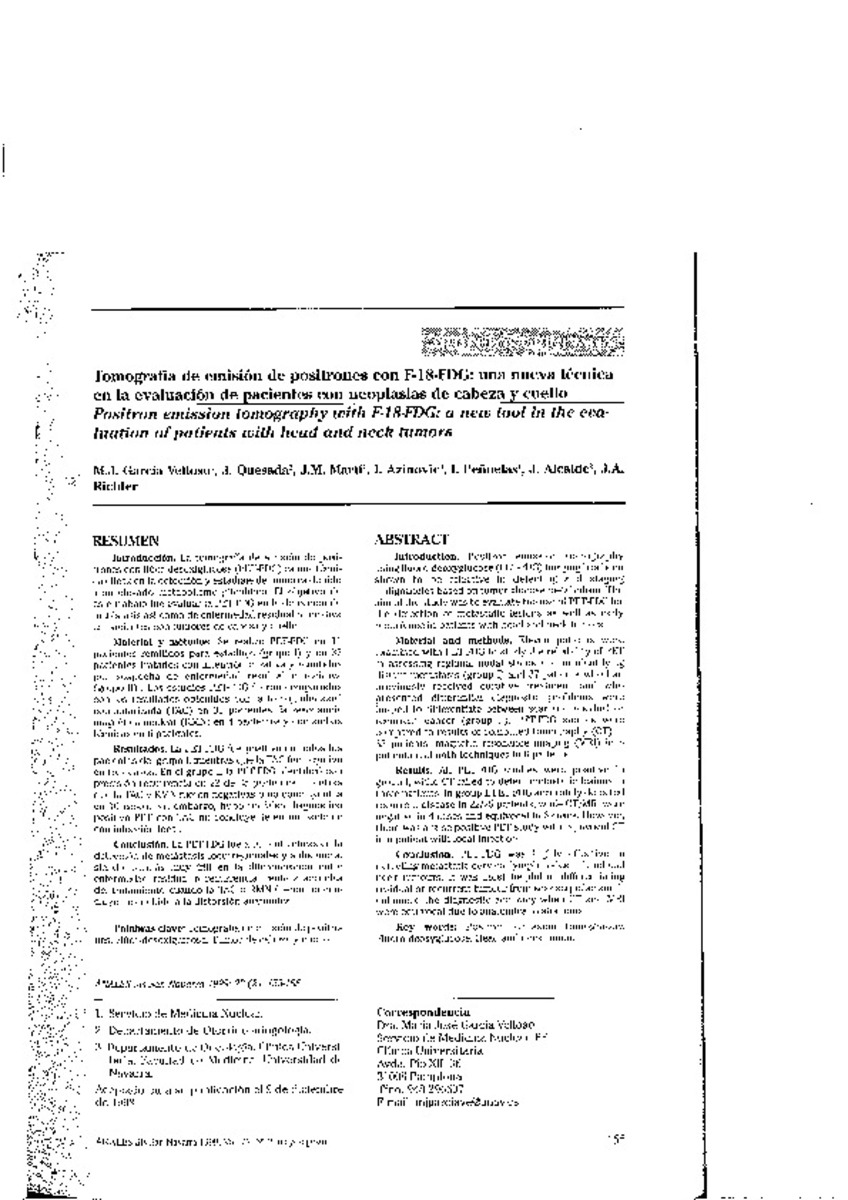Full metadata record
| DC Field | Value | Language |
|---|---|---|
| dc.creator | Garcia-Velloso, M. J. (María José) | - |
| dc.creator | Quesada, J. (J.) | - |
| dc.creator | Marti, J.M. (J.M.) | - |
| dc.creator | Azinovic, I. (Ignacio) | - |
| dc.creator | Peñuelas-Sanchez, I. (Ivan) | - |
| dc.creator | Alcalde, J. (Juan) | - |
| dc.creator | Richter, J.A. (José Ángel) | - |
| dc.date.accessioned | 2012-07-03T18:32:13Z | - |
| dc.date.available | 2012-07-03T18:32:13Z | - |
| dc.date.issued | 1999 | - |
| dc.identifier.citation | Garcia Velloso MJ, Quesada J, Marti JM, Azinovic I, Peñuelas I, Alcalde J, et al. Tomografía de emisión de positrones con F-18-FDG: una nueva técnica en la evaluación de pacientes con neoplasias de cabeza y cuello. An Sist Sanit Navar 1999 May-Aug;22(2):155-165. | es_ES |
| dc.identifier.issn | 1137-6627 | - |
| dc.identifier.uri | https://hdl.handle.net/10171/22810 | - |
| dc.description.abstract | INTRODUCTION: Positron emission tomography using fluoro-deoxyglucose (PET-FDG) imaging has been shown to be effective in detecting and staging malignancies based on tumor glucose metabolism. The aim of the study was to evaluate the use of PET-FDG for the detection of metastatic lesions as well as early recurrence in patients with head and neck tumors. MATERIAL AND METHODS: Eleven patients were examined with PET-FDG to study the reliability of PET in assessing regional nodal status and in identifying distant metastasis (group I) and 37 patients who had previously received curative treatment and who presented differential diagnostic problems were imaged to differentiate between scar and residual or recurrent cancer (group II). PET-FDG studies were compared to results of computed tomography (CT) in 35 patients, magnetic resonance imaging (MRI) in 4 patients and both techniques in 6 patients. RESULTS: All PET-FDG studies were positive in group I, while CT failed to detect metastatic lesions in three patients. In group II PET-FDG accurately detected recurrent disease in 22/25 patients, while CT/MRI were negative in 4 cases and equivocal in 6 cases. However, there was a false positive PET study with equivocal CT in a patient with local infection. CONCLUSION: PET-FDG was highly effective in detecting metastatic cervical lymph nodes in head and neck tumours. It was most helpful in differentiating residual or recurrent tumour from scar sequelae and it enhanced the diagnostic accuracy when CT and MRI were equivocal due to anatomical distortions. | es_ES |
| dc.language.iso | spa | es_ES |
| dc.publisher | Gobierno de Navarra. Departamento de Salud | es_ES |
| dc.rights | info:eu-repo/semantics/openAccess | es_ES |
| dc.subject | F-18-FDG | es_ES |
| dc.subject | Positron emission tomography | es_ES |
| dc.title | Tomografía de emisión de positrones con F-18-FDG: una nueva técnica en la evaluación de pacientes con neoplasias de cabeza y cuello | es_ES |
| dc.title.alternative | Positron emission tomography with F-18-FDG: a new tool in the evaluation of patients with head and neck tumors | - |
| dc.type | info:eu-repo/semantics/article | es_ES |
| dc.relation.publisherversion | http://www.cfnavarra.es/salud/anales/textos/index22_2.html | es_ES |
| dc.type.driver | info:eu-repo/semantics/article | es_ES |
| dc.identifier.pmid | 12886344 | - |
Files in This Item:
Statistics and impact
Items in Dadun are protected by copyright, with all rights reserved, unless otherwise indicated.






